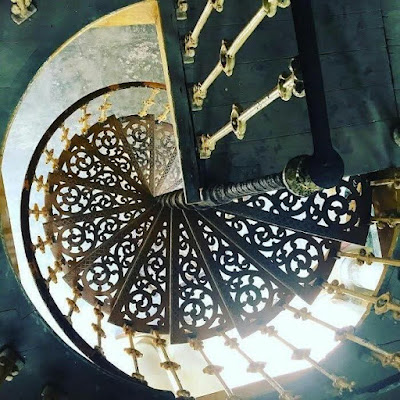Richmond Castle Mansion in Kalutara
Richmond Castle Mansion in Kalutara
There is little doubt that those researching history have come across many stories and photographs about the Richmond Castle mansion in Palathota, Kalutara. Numerous accounts and images of this residence can be found online. This house is known as one of the largest private residence in Sri Lanka.
Richmond Castle was built by Don Arthur de Silva Wijesinghe Siriwardena (12 November 1889 – 8 July 1947), the Padikara Muhandiram and later Kalutara Chief Mudaliyar, son of Nanayakkara Appuhamilage Don Paulus Silva (1838–1901). Don Paulus Silva, his father, provided the financial backing for the construction of this grand mansion.
 |
| Mudaliyar Don Arthur de Silva Wijesinghe Siriwardena |
 |
| Mudaliyar Arthur with his Security |
 |
| Don Paulus Silva |
 |
| Paulus Silvas graphite Store and Office |
Don Paulus Silva was one of the leading businessmen in the island during the 19th century. Born in Badddegama, Galle District, he lost both his parents at the age of eleven and became an orphan. At the age of eighteen, with only a small amount of money in hand, he first moved to Colombo and then to Kurunegala, starting his business career with a coffee store.
Later, he entered the graphite mining industry, which was so profitable that he earned the nickname “Graphite King.” Wisely investing the profits from graphite into coconut, coffee, tea, rubber, cinchona, cinnamon, and spice plantations, he expanded his wealth. During the 1890s, he became a successful toll collector (renter) of public roads and liquor licenses, becoming a member of the influential association of arrack renters of the time.
In 1896, he secured the Victoria Bridge toll collection rights for £7,000 and the Bambalapitiya Bridge for £4,100. From 1893 to 1897, he won liquor rental rights for Siyane and Hewagam Korales in a single year, spending a total of £7,800 in 1897. In 1893 and 1894, he joined Don Spater Senanayake to purchase the lucrative arrack rental rights in the Negombo District.He also owned vast estates in the North Western Province, such as the 700-acre Gorakadola Estate, as well as estates in Maduragoda, Hollandgolla, Malkaduwa, and Paragahadeniya. In the Western Province, he owned plantations like Maliduwakanda, Irahandayawa, Wil Imbula, Mandawala, Kithulkale, and Rathmalgoda. In Ratnapura, he possessed the 1,025-acre Bambarabotuwa tea estate and factory. Moreover, he owned Sri Lanka's largest arrack warehouse in Kalutara, which had a capacity of 5,000 gallons.At the time of his death, he employed approximately 7,000 individuals across all his businesses. His residence and office were located at the Kollupitiya junction, in a building named "Isabel Court" after his wife. It was also in this house that Arthur de Silva Mudaliyar was born.
Don Paulus Silva’s son-in-law, the distinguished lawyer and judge A.C.G. Wijeyekoon (Abraham Charles Gerard Wijeyekoon, 1878–1952), was appointed to the Legislative Council in 1921 and later became the first President of the Senate of Ceylon.A well known philanthropist, Don Paulus Silva built a ward at Lady Havelock Hospital named after himself. He also constructed several churches and schools and was a major benefactor of St. Joseph’s College and the Good Shepherd Convent. He reportedly paid pensions to around 150 retirees monthly. He declined the prestigious “Basnayake Mudaliyar” title offered to him by the British Crown on three separate occasions.
Don Paulus Silva had two marriages. From his first wife, he had two sons Bernard and Steven. His second wife was Dona Isabella Wijesinghe, the daughter of Pagoda Wijesinghe Arachchi. The creator of Richmond Castle, Mudaliyar Arthur, was the son of Paulus and Isabella. They also had one daughter.
 |
| Bernard De Silva |
 |
| Dona Isabella Wijesinghe |
 |
| Isabella Wijesinghe and Family |
 |
| Isabel court Mansion |
 |
| A recent picture of Isabel court |
Arthur and his brother Hector received their education in Great Britain. Upon returning to Ceylon, Arthur was appointed the Chief Mudaliyar of Kalutara. He became the head among twelve Mudaliyars. When constructing Richmond Castle, Mudaliyar Arthur wished to build a mansion similar to that of his friend, Raja Rajeswara Sethupathi (1889–1929), who ruled over the Ramnad region in Tamil Nadu, India, from 1903 to 1929.However, when Arthur inquired with the Maharaja about replicating the design, the latter declined, suggesting that building such a grand mansion in a small country like Ceylon lacking both manpower and wealth would be impractical. Undeterred, Arthur brought an experienced architect and mason from Kalutara’s Kudaligama area to India, where they studied the architectural design of the Sethupathi Palace in Ramanathapuram before returning to Ceylon.
Though Richmond Castle was not an exact replica of the much older Sethupathi Palace, it emerged as a unique architectural marvel inspired by it.
 |
| Maharaja Raja Rajeswara Sethupathi |
 |
| Sethupathi Mansion |
 |
| Maharahja at Mudaliyar Arthurs wedding Ceremony |
Special Architectural Features of Richmond Castle:
The mansion consists of 99 doors and 34 windows, all made from imported teak wood from Burma (Myanmar).
The main lobby features a grand staircase made of carved teak, symmetrically rising on either side.
It is a two-story building containing 14 rooms, with dance halls and dining rooms on both floors. The floors of the dance halls are made of oak wood.
The decorative stained glass windows were imported from Italy.
Prior to 1910, the upper-floor bathrooms were supplied with water via galvanized pipes, an advanced feature for that time.
Rainwater from the roof was collected and circulated through clay pipes beneath the floor to cool the building naturally.
Bathroom fixtures and roof tiles were imported from England.
The dance hall’s wooden floor was designed with vents connected to underground pipes to channel cool breezes from the nearby Kalu Ganga (Black River).
For soundproofing, the bedrooms had wood paneling on the interior walls.
In the garden, there were 12 granite statues, 7 child statues, and a statue of a mother with a child, positioned facing the Mudaliyar’s bedroom.
In addition to the grand central staircase in the lobby, there was a side staircase for the servants.
On May 10, 1910, Arthur de Silva Mudaliyar married Clarice Matilda Maud Suriya Bandara, a noblewoman from the Kandyan aristocracy. The mansion was officially opened on the same day as their wedding. Despite 31 years of marriage, the couple remained childless.On July 4, 1941, Arthur legally dissolved the marriage. That very day, he also drafted his last will. Having lived in seclusion for several years, he passed away alone on July 8, 1947, in Room No. 37 of the Queen’s Hotel, Kandy.
As per his final wishes, since 1956, the Richmond Castle has been under the administration of the Public Trustee Department of Sri Lanka.
Sources:
Twentieth Century Impressions of Ceylon – Arnold Wright (1907)
From Nobodies to Somebodies: The Rise of the Bourgeoisie in Sri Lanka – Dr. Kumari Jayawardena (1998)
Open-source media






















Comments
Post a Comment